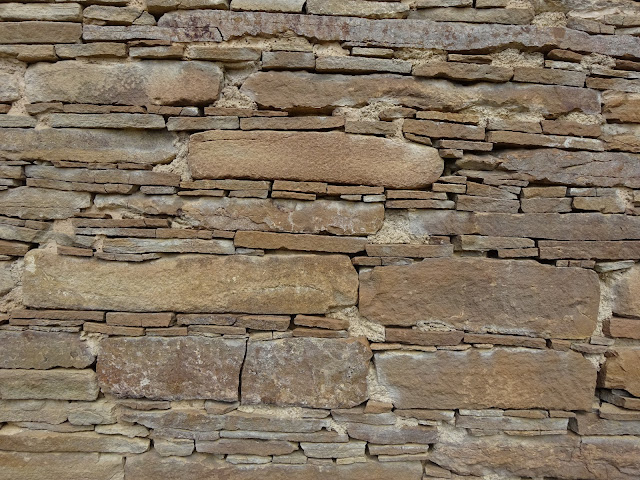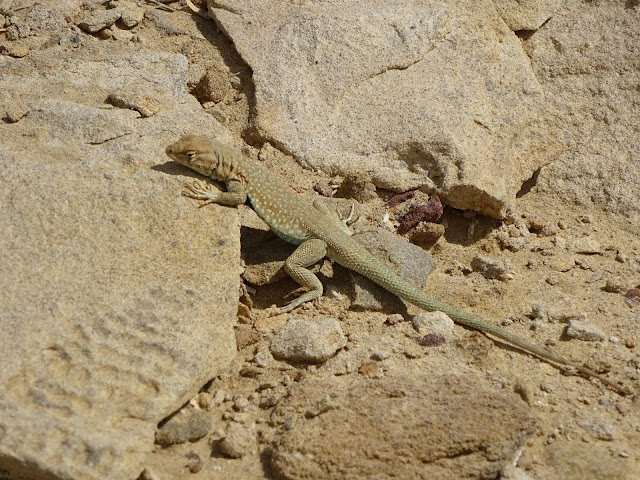Kivas are assumed to be ceremonial meeting places. Casa Rinconada is the largest excavated kiva in the park.
There is evidence of continued expansion of the
multi-story stone buildings with different masonry techniques, some of which
are shown below.
The rocks provide habitat for many different reptiles. The lizard below is eating a stick insect.
We camped in the canyon, just a few metres from excavated ruins and gorgeous sandstone cliffs.
The next day we explored the park on bicycles .....
.... and got caught in another hail/rain storm!
The roads to Chaco are unpaved and are (yet
again) impassable when wet. Due to the thunderstorm, the surface became very
slippery and we were fishtailing all over the road! We must have been the last
ones driving out that day - thanks to Kirsten's excellent driving skills! A week earlier 20 cars got stuck in the same
location because one vehicle ended up sideways and blocked the road.
An arroyo (usually dry creek bed) in flood.
Ancestral Pueblo people lived in over 3,000 sites in the Frijoles Canyon and today's Bandelier National Monument. By mid-1500s the houses were abandoned (like so many other cliff dwellings in the area), presumably due to climate change. The park is named after the Swiss self-taught anthropologist Adolph F.A. Bandelier, who visited and wrote about hundreds of sites in new Mexico, Peru and Bolivia.
The "long house" is an 800-foot stretch of adjoining, multi-storied stone homes with hand-carved caves as back rooms.
The Alcove House can only be reached via a 140 foot climb on four ladders.
The Gila Cliff Dwellings include pit houses from 550 to surface pueblos dating to 1400. The natural caves formed over 28 million years and are a combination of volcanic layers and sedimentary rock. Due to its remoteness, the park has few visitors and full access into the caves and dwelling is permitted, which was a lot of fun!
A section of the Great Divide Mountain Bike Route leads through Gila National Forest.
These critters are crevice spiny lizards (Sceloporus poinsettii) and the love to be photographed!
We were also lucky to see a Spotted Owl.
A quick visit to Los Alamos and the Bradbury Science Museum gave us a depressing insight into the area's infamous history. The statues are of Dr. J. Robert Oppenheimer and General Leslie R. Groves, the "fathers" of the world's first atomic bombs.
We stayed in the Hilton Santa Fe Buffalo Thunder hotel, which is also a casino. In about 2 minutes I gambled $15 and won $0.36! We didn't like the odds and spent the money on drinks instead!
It was still raining regularly and the lawn of the hotel turned into a duck pond.
The old town of Santa Fe has some interesting architecture....
... and a fascinating door on the Cathedral Basilica of St. Francis of Assisi.
Our last park before going home was White Sands National Monument, the largest gypsum dunefield in the world (275 square miles). It forms part of the White Sands Missile Range, which is still used by the US Department of Defense - we didn't linger for too long!
El Paso is the "cowboy boot capital" of the US, so we had to investigate. What an amazing selection of colours and leather from many different animals, including ostrich, alligator, elephant, snake, fish, lama, buffalo, deer, crocodile, various lizards, shark, stingray and kangaroo. Unfortunately, the boots were all identical in shape and the ladies' selection was much more limited.

















































Snap - we will have to compare our photos from when we were in the same place 25 years ago.
ReplyDelete